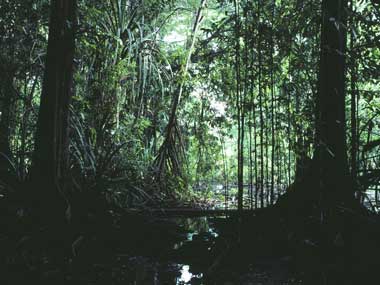Christmas Island is an Australian External Territory located in the Indian Ocean approximately 2800 kilometres west of Darwin and 500 kilometres south of Jakarta, Indonesia. The Island is approximately 13 500 hectares in size and contains two Ramsar wetlands: The Dales and Hosnies Spring. The Dales Ramsar site covers 583 hectares and is located on the western coastline of Christmas Island. The western boundary of the Ramsar site extends 50 metres seaward from the low water mark and incorporates part of the coastline. The Dales are located within the Christmas Island National Park which is managed by Parks Australia. The Ramsar site has a near-pristine system of seven watercourses collectively known as The Dales. The Dales includes permanent and perennial streams, permanent springs, and include the majority of surface water on the Island. Most rainfall on Christmas Island filters down through the soil and limestone, and surface runoff only occurs after heavy rain. The Dales contain numerous wetland types including surface and karst features, and inland and coastal wetlands. The Dales support a number of unique ecological and geomorphic features including anchialine cave communities, surface karst including the unique stepped tufa deposits at Hugh’s waterfall, a stand of Tahitian chestnuts, a large number of endemic terrestrial species and a significant number of seabirds including Abbott’s booby, red-footed booby and the brown booby, all of which breed at the site. Vegetation in The Dales ranges from tall plateau rainforest to lower coastal vegetation. Migratory or vagrant bird species use The Dales as a staging site during migration, and a landfall for vagrant bird species outside their range. Christmas Island is also an important habitat, breeding and spawning area for land crabs. The endemic red crab, tens of millions of which live on the island, migrate from the forest to the coast each year for the breeding season. Blue crabs in particular are reliant on the Ramsar site, as they require freshwater to maintain renal function. During the wet season there is sufficient surface water in forests to maintain gill functioning in blue crabs and they can range over large areas of Christmas Island. However, during the dry season they are restricted to permanent freshwater sources, such as that provided by The Dales. The Dales are used for conservation and recreation, including sightseeing, walking and camping
The Dales

Government evidence of impact of climate change:
-
Australian Government, The Dales Ramsar Site, Ecological Character Description
Increased visitor impacts leading Certain Current to physical disturbance of the site Climate change Reduced altered recharge of Medium Medium to long altered rainfall aquifer and loss of freshwater. term patterns.
Climate change Direct physical damage to Medium Medium to long increased waterbird breeding habitat. term intensity of storms.
Climate change Increased incidence of coral Certain (for Current (disease increased bleaching and disease. coral outbreak summer temperature. bleaching) 2007 2008 coral bleaching 1997 1998 and 2010). xi There is no evidence that there has been any change to any of the critical components; processes or services since the site was listed.
Climate Habitat template Geomorphic setting Hydrology Water quality Waterbirds Land crabs Fish Coral Terrestrial threatened species Invertebrates (non crab) Terrestrial vegetation Biodiversity Food webs Near natural wetaland types Threatened species Distinct or unique wetland species Special ecological; physical or geomorphic features Ecological connectivity Criterion Criterion Criterion Criterion Criterion Critical services Critical components processes Essential elements Figure 5 Simple conceptual model showing the key relationships between components and processes benefits and services and the reasons for the site being listed as a Wetland of International Importance. 3.2 Essential elements The components and processes of The Dales Ramsar site that are considered important in supporting the critical components; processes; benefits and services of the site (and hence termed essential elements ) are described briefly below and summarised in Table 4.
Threat Invasive Species Recreation Groundwater Extraction Climate Change Stressor Yellow crazy ant (Anoplolepis gracilipes) Increased physical disturbance Potentially reduced discharge Variable rainfall Increased temperature Increased intensity of storms Increased predation on land animals Decreased terrestrial vegetation health Coral bleaching Altered community composition Ecological effects Decreased population crabs Changed wetland type Disruption of critical life stage crab migratory pathways Disruption of critical life stage seabird rookeries Facilitation of invasive weeds Component; process; or service Crab fauna; Waterbirds Services Near natural wetland ecosystem Food webs Crab fauna (red crabs) Services Ecological connectivity Distinct wetland species Waterbirds Services Biodiversity Natural wetland eco system Threatened species Physical habitat Hydrology Services Near natural wetland ecosystem Marine fish and coral Services Physical habitat Biodiversity Figure 27 Stressor model of major threats to ecological character of The Dales Ramsar site (after Gross 2003 and Davis and Brock 2008). 5.1 Invasive species (yellow crazy ants) Yellow crazy ants (Anoplolepis gracilipes) are thought to have been introduced to Christmas Island between 1915 and 1934 (O’Dowd et al. 1999).
There is uncertainty in the predicted change in climate for Christmas Island; but in general it is thought that rainfall could decrease and that the intensity of tropical cyclones could increase (McInnes et al. 2008).
Recent modelling is not clear on if rainfall will change due to greenhouse effects; however McInnes et al. (2008) suggest that rainfall decreases are more likely than increases in the driest seasons of the year; winter and spring; and in the annual average rainfall total; which is likely to change by 10 to 3 percent by 2030 and by 28 to 9 percent by 2070 (McInnes et al. 2008).
Fishes and many calcareous organisms (for example corals) will also be negatively affected by the increasing acidity of the oceans associated with global warming (Hoegh Guldberg et al. 2007 Munday et al. 2008) Figure 29 Coral bleaching at Christmas Island (Image courtesy J P Hobbs; James Cook University). 5.3 Natural system modification groundwater extraction There is little permanent surface water on Christmas Island; and water for consumptive uses is extracted from the unconfined aquifers.


